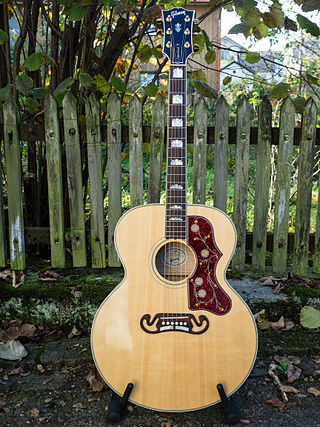
The steel-string acoustic guitar is a modern form of guitar that descends from the gut-strung Romantic guitar, but is strung with steel strings for a brighter, louder sound. Like the modern classical guitar, it is often referred to simply as an acoustic guitar, or sometimes as a folk guitar.

An electric guitar is a guitar that requires external amplification in order to be heard at typical performance volumes, unlike a standard acoustic guitar. It uses one or more pickups to convert the vibration of its strings into electrical signals, which ultimately are reproduced as sound by loudspeakers. The sound is sometimes shaped or electronically altered to achieve different timbres or tonal qualities from that of an acoustic guitar via amplifier settings or knobs on the guitar. Often, this is done through the use of effects such as reverb, distortion and "overdrive"; the latter is considered to be a key element of electric blues guitar music and jazz, rock and heavy-metal guitar-playing. Designs also exist combining attributes of the electric and acoustic guitars: the semi-acoustic and acoustic-electric guitars.

The guitar is a stringed musical instrument, that is usually fretted and typically has six or twelve strings. It is usually held flat against the player's body and played by strumming or plucking the strings with the dominant hand, while simultaneously pressing selected strings against frets with the fingers of the opposite hand. A guitar pick may also be used to strike the strings. The sound of the guitar is projected either acoustically, by means of a resonant hollow chamber on the guitar, or amplified by an electronic pickup and an amplifier.

Jazz guitar may refer to either a type of electric guitar or a guitar playing style in jazz, using electric amplification to increase the volume of acoustic guitars.

A mandolin is a stringed musical instrument in the lute family and is generally plucked with a pick. It most commonly has four courses of doubled strings tuned in unison, thus giving a total of eight strings. A variety of string types are used, with steel strings being the most common and usually the least expensive. The courses are typically tuned in an interval of perfect fifths, with the same tuning as a violin. Also, like the violin, it is the soprano member of a family that includes the mandola, octave mandolin, mandocello and mandobass.

C.F. Martin & Company is an American guitar manufacturer established in 1833 by Christian Frederick Martin. It is highly respected for its acoustic guitars and is a leading manufacturer of flat top guitars. The company has also made mandolins and tiples, as well as several models of electric guitars and electric basses, although none of these other instruments are still in production.
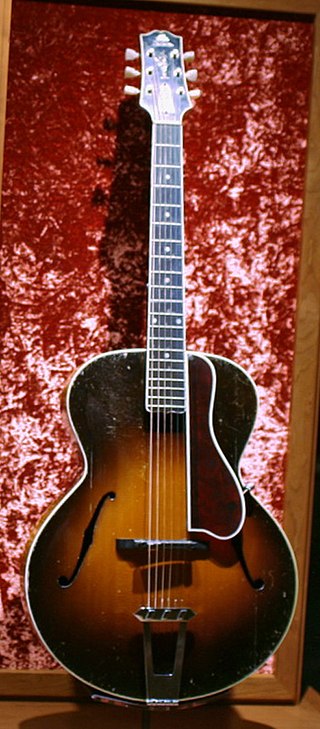
The Gibson L-5 is a hollow body semi-acoustic guitar first produced in 1923 by the Gibson Guitar Corporation, then of Kalamazoo, Michigan. The first guitar to feature F-holes, the L-5 was designed under the direction of acoustical engineer and designer Lloyd Loar, and has been in production ever since. It was considered the premier guitar of the company during the big band era. It was originally offered as an acoustic instrument, with electric models not made available until the 1940s.

Epiphone is an American musical instrument brand that traces its roots to a musical instrument manufacturing business founded in 1873 by Anastasios Stathopoulos in Smyrna, Ottoman Empire, and moved to New York City in 1908. After taking over his father's business, Epaminondas Stathopoulos named the company "Epiphone" as a combination of his own nickname "Epi" and the suffix "-phone" in 1928, the same year it began making guitars. From the 1930s through to the early 1950s, Epiphone produced a range of both acoustic and (later) electrified archtop guitars that rivalled those produced by Gibson and were the instruments of choice of many professionals; a smaller range of flat-top guitars were also produced, some designations of which were later continued during the Gibson-owned era for the company.

The Bigsby vibrato tailpiece is a type of mechanical vibrato device for electric guitar designed by Paul Bigsby and produced by the Bigsby Electric Guitar Company. The device allows musicians to bend the pitch of notes or entire chords with their pick hand for various effects.
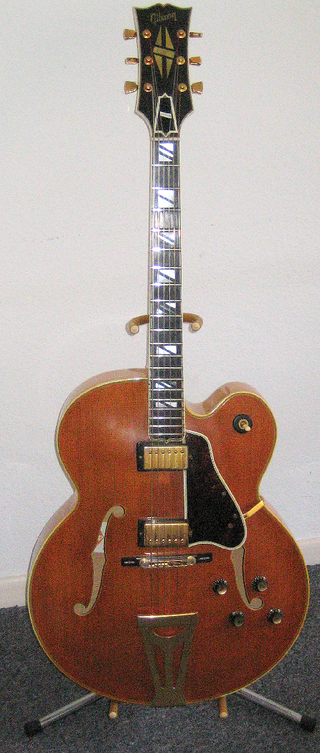
An archtop guitar is a hollow acoustic or semi-acoustic guitar with a full body and a distinctive arched top, whose sound is particularly popular with jazz, blues, and rockabilly players.

The Selmer guitar — often called a Selmer-Maccaferri or just Maccaferri by English speakers, as early British advertising stressed the designer rather than manufacturer — is an unusual acoustic guitar best known as the favored instrument of Django Reinhardt. Selmer, a French manufacturer, produced the instrument from 1932 to about 1952.
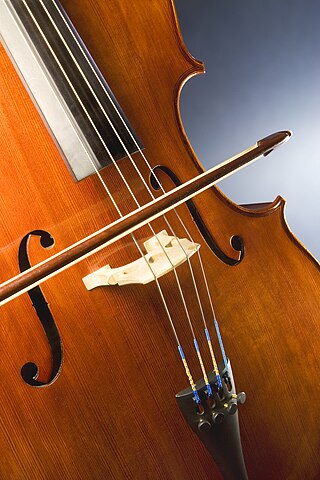
A sound hole is an opening in the body of a stringed musical instrument, usually the upper sound board. Sound holes have different shapes:
John D'Angelico was a luthier from New York City, noted for his handmade archtop guitars and mandolins. He founded the D'Angelico Guitars company, where other notable luthiers like Jimmy D'Aquisto served as apprentices.

Levin was a Swedish manufacturer of musical instruments founded by Herman Carlson Levin. Active from 1900 to 1978, the company produced over half a million instruments, mostly guitars, but also mandolins, banjos and lutes, making Levin the largest instrument manufacturer in Scandinavia for many years. Levin is best known for originating Goya acoustic guitars.
Guitar bracing refers to the system of wooden struts which internally support and reinforce the soundboard and back of acoustic guitars.
Mississippi Delta bluesman Robert Leroy Johnson has been called the "King of the Delta Blues Singers", the "Grandfather of Rock and Roll" and "the most important blues singer that ever lived". The guitars he played, recorded and was photographed with have always been of interest to blues researchers and musicologists, and this interest eventually led to the production of guitars dedicated to his memory.

Collings Guitars is an Austin, Texas–based stringed instrument manufacturer. The company was founded in 1973 by BillCollings. In addition to acoustic guitars, Collings Guitars manufactures electric guitars, archtop guitars, mandolins and ukuleles.
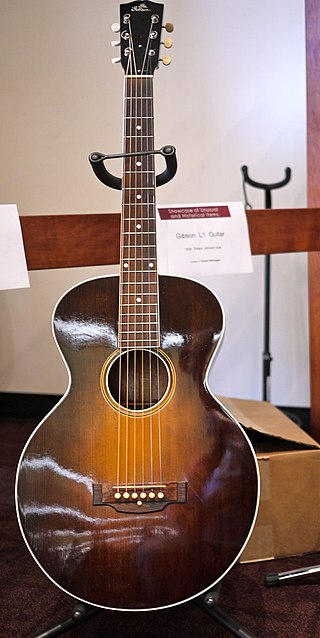
The Gibson L-1 is an acoustic guitar that was first sold by the Gibson Guitar Corporation in the early 20th century. The L-1 model was introduced first as an archtop (1902), and later as a flat top in 1926. The model is famously associated with the legendary bluesman Robert Johnson.

The Gibson ES-350T is an electric guitar model from Gibson Guitar Corporation, released in 1955. The ES-350T is a further development of the Gibson ES-350 model from 1948 and as such has a completely hollow body. The unique feature of the Gibson ES-350T at the time of its market introduction was the reduced width of the rims. As a result, the guitar has a thinner body compared to instruments with a resonance body that is of full thickness. The ES-350T, together with its sister models Gibson ES-225 TDN and Gibson Byrdland, was one of the first models of the thinline guitar type.

Grimshaw Guitars was a British manufacturer of guitars and related instruments from the 1930s to the 1980s, known for producing acoustic archtop guitars in the 1930s–1940s, electrified archtop guitars in the 1940s and 1950s, semi-solid (thinline) electric guitars in the 1950s–1960s, and mainly solidbody guitars from the late 1950s to 1980s, along with smaller quantities of banjos, hawaiian guitars, electric bass guitars, acoustic guitars and nylon string guitars. Their archtop guitars were used by British players from the 1930s to the 1950s, when equivalent U.S.-made instruments were difficult to obtain in Britain, and their early electric thinline instruments such as the "S.S.1" and "S.S.1 deluxe" were popular with British "beat" groups of the early 1960s. Sales declined in the later 1960s and 1970s with easier access by customers to better made U.S. instruments at one end of the scale, and cheaper imported instruments, mostly from Japan, with which the Grimshaw line could not compete on price. The Grimshaw factory closed in the mid 1980s and its junior partner founder, Emile Grimshaw Jnr, passed away in 1987. Since that time, surviving instruments occasionally appear on the used market but tend to be somewhat overshadowed in favour of better known instruments of similar age by other British manufacturers such as Burns, Vox, etc.















